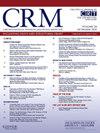TAVR术后新发LBBB患者左心室功能障碍和不同步的发生率和进展。
IF 1.6
Q3 CARDIAC & CARDIOVASCULAR SYSTEMS
引用次数: 0
摘要
背景:经导管主动脉瓣置换术(TAVR)后新发左束支传导阻滞(N-LBBB)对心功能和机械不同步的影响尚未明确:我们回顾性地筛查了2018年10月至2021年9月期间在本中心接受TAVR的所有患者(n = 409)。我们确定了 38 例术后出现 N-LBBB 的患者(其中 28 例为持续性,10 例为短暂性),以及 17 例术后出现慢性前期 LBBB(C-LBBB)的患者。我们排除了 TAVR 术后需要起搏的患者。我们回顾性分析了所有组别在3个时间点储存的超声心动图:TAVR前(T0)、TAVR后早期(T1,1.2±1.1天)和随访后期(T2,1.5±0.8年),比较了左心室质量和容积、左心室功能指数(左心室射血分数,LVEF;整体纵向应变,GLS)和机械不同步指数(收缩期舒张指数、室间隔闪光严重程度):结果:与N-LBBB患者相比,基线(T0)时C-LBBB患者的心功能更差,左心室容积和左心室质量更大。在T1,N-LBBB导致轻度不同步,LVEF和GLS下降。在T2期,持续性N-LBBB患者的不同步程度加深,而C-LBBB患者则没有。不过,两组患者的 LVEF 在 T2 阶段均保持稳定,但个体反应不一。基线时 LVEF 较好的患者在 T2 期出现 LBBB 引起的左心室功能障碍的比例较高。TAVR 术后 LVEF 没有立即改善,预示着 T2 时 LVEF 会恶化。在一过性LBBB中,心功能和大多数不同步指数恢复至基线:结论:TAVR术后的N-LBBB会导致心功能立即下降,尽管只有轻微的不同步。当LBBB持续存在时,TAVR前心功能较好的患者在TAVR后更有可能出现LBBB引起的左心室功能障碍。本文章由计算机程序翻译,如有差异,请以英文原文为准。
Prevalence and progression of LV dysfunction and dyssynchrony in patients with new-onset LBBB post TAVR
Background
The impact of new-onset left bundle branch block (N-LBBB) developing after Transcatheter Aortic Valve Replacement (TAVR) on cardiac function and mechanical dyssynchrony is not well defined.
Methods
We retrospectively screened all patients who underwent TAVR in our centre between Oct 2018 and Sept 2021 (n = 409). We identified 38 patients with N-LBBB post-operatively (of which 28 were persistent and 10 were transient), and 17 patients with chronic pre-existent LBBB (C-LBBB). We excluded patients requiring pacing post TAVR. For all groups, we retrospectively analysed stored echocardiograms at 3 time points: before TAVR (T0), early after TAVR (T1, 1.2 ± 1.1 days), and late follow-up (T2, 1.5 ± 0.8 years), comparing LV mass and volumes, indices of LV function (LV ejection fraction, LVEF; global longitudinal strain, GLS), and mechanical dyssynchrony indices (systolic stretch index, severity of septal flash).
Results
At baseline (T0), C-LBBB had worse cardiac function, and larger LV volumes and LV mass, compared with patients with N-LBBB. At T1, N-LBBB resulted in mild dyssynchrony and decreased LVEF and GLS. Dyssynchrony progressed at T2 in persistent N-LBBB but not C-LBBB. In both groups however, LVEF remained stable at T2, although individual response was variable. Patients with better LVEF at baseline demonstrated a higher proportion of developing LBBB-induced LV dysfunction at T2. Lack of improvement of LVEF immediately after TAVR predicted deteriorating LVEF at T2. In transient LBBB, cardiac function and most dyssynchrony indices returned to baseline.
Conclusions
N-LBBB after TAVR results in an immediate reduction of cardiac function, in spite of only mild dyssynchrony. When LBBB persists, patients with better cardiac function before TAVR are more likely to have LBBB-induced LV dysfunction after TAVR.
求助全文
通过发布文献求助,成功后即可免费获取论文全文。
去求助
来源期刊

Cardiovascular Revascularization Medicine
CARDIAC & CARDIOVASCULAR SYSTEMS-
CiteScore
3.30
自引率
5.90%
发文量
687
审稿时长
36 days
期刊介绍:
Cardiovascular Revascularization Medicine (CRM) is an international and multidisciplinary journal that publishes original laboratory and clinical investigations related to revascularization therapies in cardiovascular medicine. Cardiovascular Revascularization Medicine publishes articles related to preclinical work and molecular interventions, including angiogenesis, cell therapy, pharmacological interventions, restenosis management, and prevention, including experiments conducted in human subjects, in laboratory animals, and in vitro. Specific areas of interest include percutaneous angioplasty in coronary and peripheral arteries, intervention in structural heart disease, cardiovascular surgery, etc.
 求助内容:
求助内容: 应助结果提醒方式:
应助结果提醒方式:


